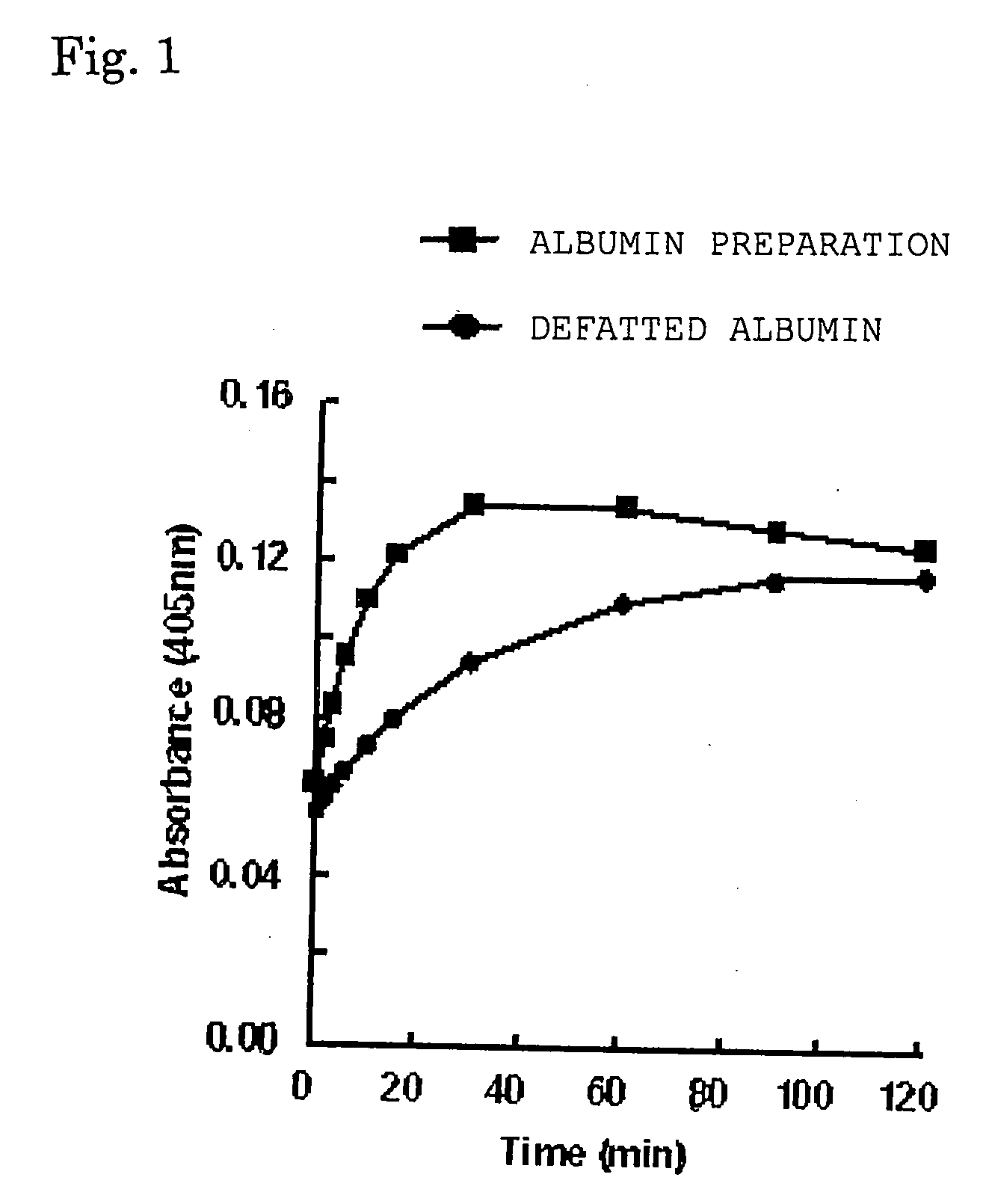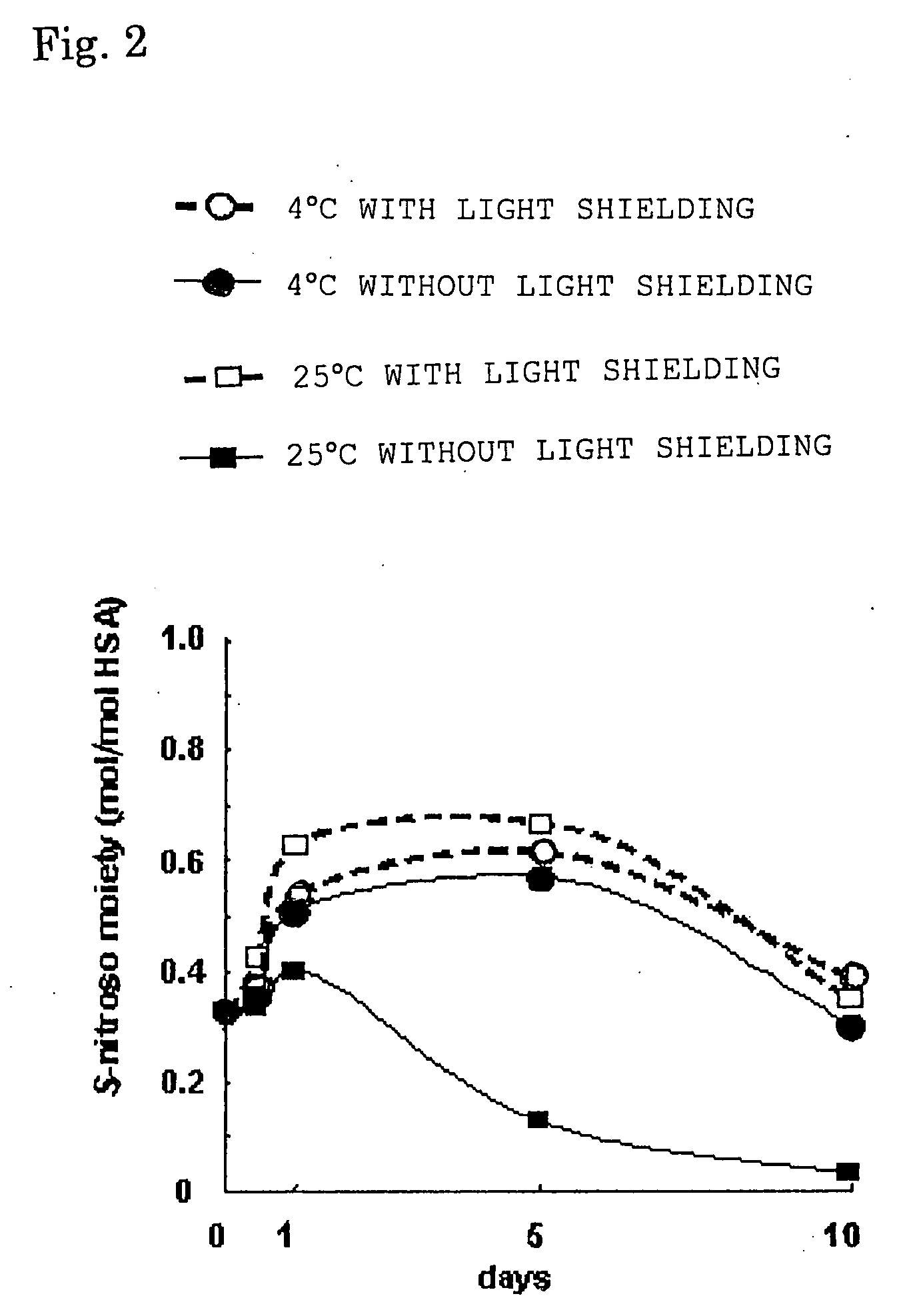S-nitrosoprotein preparation and production method therefor
a technology of nitrosoprotein and stabilizing agent, which is applied in the direction of peptides, drug compositions, peptides/protein ingredients, etc., can solve the problems of low reactivity, difficult selective obtention of advantageous effects, and no disappearance in an extremely short time in living organisms, etc., to achieve efficient nitrosylation, use of nitrosylated proteins, and potent antibacterial
- Summary
- Abstract
- Description
- Claims
- Application Information
AI Technical Summary
Benefits of technology
Problems solved by technology
Method used
Image
Examples
example 1
[0050] A 300 μM HSA solution containing 1.6 mM caprylic acid and 1.86 mM N-acetyltryptophane was prepared. To the HSA solution was added GSNO in an amount five times that of the HSA by mole ratio and the resultant was allowed to react at 37° C. for 1 minute to obtain an S-nitroso-HSA sample. Then, aliquots of sample were subjected to storage tests for 10 days under conditions of 4° C. with light shielding, 4° C. without light shielding, 25° C. with light shielding, and 25° C. without light shielding, respectively, and NO concentrations were measured with time by an HPLC-flow reaction system method using a Griess reagent to confirm the nitrosylated state of HSA.
[0051] The result obtained is illustrated in FIG. 2. The ordinate axis indicates S-nitroso moiety, that is, NO addition rate. The symbol ---∘--- indicates a storage condition of 4° C. with light shielding; the symbol --●-- indicates a storage condition of 4° C. without light shielding; the symbol ---□--- indicates a storage c...
example 2
[0054] A 300 μM HSA solution containing 1.6 mM caprylic acid and 1.86 mM N-acetyltryptophane was prepared. To this was added a 1.5 mM S-nitrosoglutathione (GSNO) solution and the resultant was mixed at 37° C. for about 30 minutes with light shielding to obtain an S-nitroso-HSA sample. Then, the sample was measured for NO concentration by an HPLC-flow reactor system method using a Griess reagent to confirm the nitrosylation of HSA.
experimental example 1
[0055] To confirm the structure of S-nitrosoalbumin obtained in Example 2, circular dichroic spectrum (hereinafter abbreviated as CD-spectrum) was measured (using a Jasco corporation J-720 Model spectropolarimeter). The results obtained are illustrated in FIG. 3 and FIG. 4.
[0056] In FIG. 3, the ordinate axis indicates [θ], that is, ellipticity per mole and the abscissa axis indicates wavelength. HSA indicated by a broken line indicates non-nitrosylated albumin and S—NO—HSA indicated by a solid line indicates nitroso-HSA sample.
[0057] In FIG. 4, the ordinate axis indicates [θ], that is, ellipticity per mole and the horizontal axis indicates wavelength. The abscissa axis indicates wavelength. HSA indicated by a broken line indicates non-nitrosylated albumin and S—NO—HSA indicated by a solid line indicates nitroso-HSA sample.
[0058]FIG. 3 indicates that the nitroso-HSA sample in a far-ultraviolet region that reflects a secondary structure exhibited substantially the same CD-spectrum ...
PUM
| Property | Measurement | Unit |
|---|---|---|
| temperature | aaaaa | aaaaa |
| temperature | aaaaa | aaaaa |
| temperature | aaaaa | aaaaa |
Abstract
Description
Claims
Application Information
 Login to View More
Login to View More - R&D
- Intellectual Property
- Life Sciences
- Materials
- Tech Scout
- Unparalleled Data Quality
- Higher Quality Content
- 60% Fewer Hallucinations
Browse by: Latest US Patents, China's latest patents, Technical Efficacy Thesaurus, Application Domain, Technology Topic, Popular Technical Reports.
© 2025 PatSnap. All rights reserved.Legal|Privacy policy|Modern Slavery Act Transparency Statement|Sitemap|About US| Contact US: help@patsnap.com



